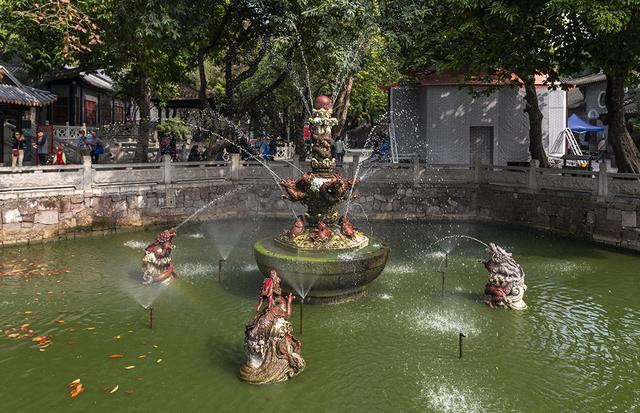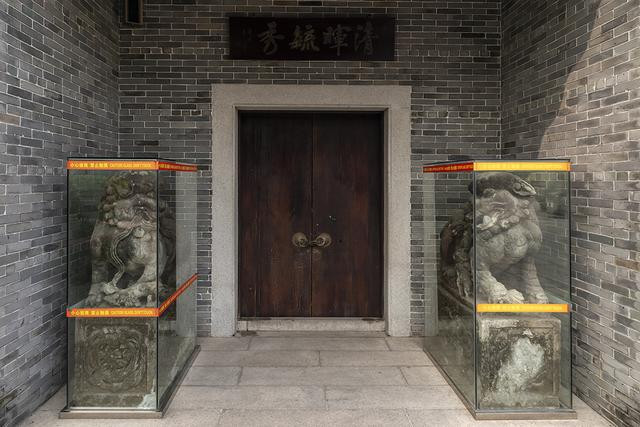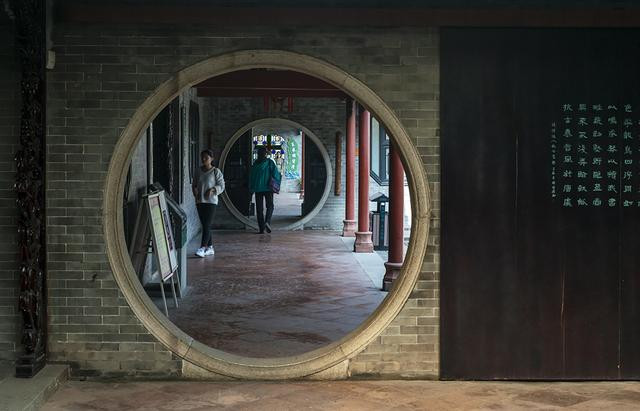Jihai Winter Solstice Tour to Flower City No. 2: Qinghui Garden
Chinese gardens are among the best in the world, and the most famous are the ten famous gardens. In 1961, the first batch of national key cultural relics protection units had four of the top ten famous gardens: Beijing Summer Palace, Suzhou Humble Administrator's Garden, Chengde Summer Resort and Suzhou Lingering Garden. The other six are national key cultural relics protection units announced in subsequent batches: Suzhou Wangshi Garden, Shanghai Yuyuan Garden, Beijing Yuanmingyuan, Wuxi Jichang Garden, Yangzhou Ge Garden, Haiyan Qiyuan, Baoding Ancient Lotus Pond and Shunde Qinghui Garden. The last one here is Shunde Qinghui Garden, which is also the only Lingnan Garden among the top ten famous gardens. That means that the best thing in Lingnan gardens is Shunde Qinghui Garden. We definitely want to visit it.
Shunde was originally a county under the jurisdiction of Foshan, a prefecture-level city. Driven by the tide of urbanization, it has now become a district of Foshan City. Foshan is very close to the Urban area of Guangzhou. It can be reached by taking the light rail on the Guangfo Line from Guangzhou. Shunde is actually very close to Guangzhou. Take the subway from our hotel to Guangzhou South Railway Station and transfer to the city rail to Shunde. It is very convenient. Then there was a public service that pulled us from the city rail station to the gate of Qinghui Garden. Below is the newly built park gate. You can enter without a ticket.

The first residence in Qinghui Garden was built by Huang Moumou, a local champion during the Wanli period of the Ming Dynasty, including a back garden. Huang Moumou's descendants were powerless and gradually fell into decline. During the Qianlong period of the Qing Dynasty, Shunde Long Yingshi passed the Jinshi, and he built Huang Moumou's house into his own house. Three generations of the Long family were Jinshi, and Long Yingshi's grandson Long Yuanren was a Jinshi during the Jiaqing period. In the eleventh year of Jiaqing (1805), Long Yuanren expanded this house into the first edition of the present Qinghui Garden, and then invited Li Zhaoluo, a scholar of the same year, to inscribe the name of the garden. The Qinghui Garden we see now has continued to expand later, including its renovation in recent years, but its foundation is still the Long Family House.
When I entered the gate, I saw a large octagonal pool with holes and dragons mixed in the pool.

Seeing these red water-spraying auspicious beasts reminds me of an ancient anecdote. It is said that in the 11th year of Hongwu of the Ming Dynasty (1388), there was a Jinshi named Xie Jin. He was quite talented and was the editor-in-chief of the Yongle Ceremony. Together with Yang Shen and Xu Wei, he was called the three great talents of the Ming Dynasty, and later became the chief assistant of the cabinet. Xie Jin was already famous for his talents when he was not promoted to the countryside of Jishui, Jiangxi Province, and he was even famous in his neighborhood for his understanding. At that time, there was a Shangshu Li who retired and returned to his hometown who also lived in Xie Jin's village. During the Hongwu period of the Ming Dynasty, there was an Uncle Li who was a Shangshu of the Ministry of Rites and was also from Jiangxi. Although Uncle Li had a sudden heart attack while serving as Minister of the Ministry of Rites, we pretended that Minister Li had retired and returned Xie Jin's hometown. One day, Shangshu Li hosted a banquet for the nearby squire and literati, so he also invited Xie Jin to have wine with him. This is a bit different. Shangshu is a quite big official, equivalent to the current minister. That Xie Jin had not yet achieved fame, so he continued to be at home every day. How can a retired minister invite an unemployed youth to drink? It turned out that this Shangshu Li was also a child prodigy when he was young. He had attended the Junior Class of the Imperial College. He was very willing to support a enterprising literary and artistic youth like Xie Jin. Speaking of which, these gentlemen felt indignant during the banquet. How could we let a poor scholar like Xie Jin drink the wine in our pot? The gentlemen ridiculed Xie Jin for fun in the name of Xie Dui. One of them saw that Xie Jin was wearing a green coat (the hat was of another color), so he asked Xie Jindui to say the above sentence: "The toad in the well wears a green coat." Xie Jin glanced sideways and saw that it was a red-robed squire whom he despised. He immediately replied,"The crabs in the pot are wearing red robes." The red-robed squire had to cover his face and come out. Now I looked at the ichthyosaurs in the pond above and remembered the crabs in the pot that Xie Jin mentioned.
A new pavilion has been built behind the fountain.

Behind the pavilion is the original Qinghui Garden gate. It is said to be a gate, but it is actually not big.

This door is very simple and unattractive. The plaque on the door says "Qing Hui Yuxiu", which was also written by Li Zhaoluo, the old man raised by a Qing Dynasty scholar. The ancient inscriptions were all explained, and there should be allusions. Qinghui: The meaning of mountains and rivers; Li Bai of the Tang Dynasty said,"Ancient mountains have pine moons, and later you play with Qinghui." Yuxiu: Nurturing talents. In the Song Dynasty, Shi Xiaoyou had "Chu Jing Yuxiu, and he was a hero in a few years." Qinghui and Yuxiu means that here "the mountains and rivers are beautiful, and talents come forth in large numbers."
The stone lion in the glass cover is a replica of an antique. It is typical of Lingnan style and looks lively. There are peonies and phoenixes on the stone pedestal. Peonies are the king of flowers, phoenix is the king of birds, and lion is the king of beasts. These are the legendary "Three Kings Lions"! Hearing is false, but seeing is believing this time.
This door is locked and is obviously not a place for tourists to enter and exit. It turns out that tourists have to go to another entrance, and there are people checking in there, so they still have to pay for tickets. When entering the garden, I saw a small black room with the inscription "Xiyin Bookstore" written on the door.

The Long family has been able to produce several generations of Jinshi, which means that it is still a scholarly family, so reading must be one of the top priorities. Every inch of time is an inch of gold. Cherishing yin means cherishing time, which definitely does not mean "unfortunately cloudy".
Next to the bookstore is a small pond, which may be the meaning of Zhu Xi's meaning that "half an acre of square ponds will open, and the sky and clouds will wander together." There is a water pavilion "Chengyi Pavilion" by the pool.

Stroll along the curving corridor by the pool and pass through several moon doors.

Such a warm pavilion is inlaid in the middle of the curved corridor.

There are gorgeous golden-painted hollow woodcut doors and gorgeous polished glass windows in the warm pavilion.

The fish leap clear and the waves are slight, and the oodles sing and the spring is green and deep. You can see Lingnan style brick carvings murals after you leave the corridor.

This building is called the boat hall and is built according to the meaning of building boat.

The second room of orchids, and the mountains of bamboo are cultivated. Although this Jiyun Small Building is just a two-room hut, the brick carving is small and romantic.

Here is another acre of fish ponds, surrounded by ponds and corridors, high shade of trees, green bamboos, and koi carp floating.

The octagonal pavilion in Lingnan is full of woodcuts.

The stacked stones form mountains, the pillars form pavilions, and there is no scenery and mane.

The gable wall, the gable gate, and a semicircular pavilion outside the door.

Look at the gold-lacquer woodcut door cover under the eaves of the peak: N orioles chirping wintersweet.

There is a big banyan tree by the pool.

There is an octagonal warm pavilion behind the tree.

The door of the warm pavilion is surrounded by complex woodcuts.

Stained glass on the door and the scenery outside the door.

The grille windows of Warm Pavilion and the window lattice of Lingnan must have a rich eye pattern.

The view outside the window.

Garden in Garden, Bamboo Garden,

The Qinghui Garden Museum is a very exaggerated bird.

Lingnan style small grid windows with gold lacquer window frames.

The mountain top of the mountain, which is rare in Lingnan, is decorated with gray carvings and hanging fish and grass on the enclosed mountain flowers.

There is an official hat in this room.

It turned out to be the No. 1 Champion Hall.

The top scorer in the Ming and Qing Dynasties was the first place in the court examination. This Zhuangyuan Hall was originally the Hongqu Bookstore in Qinghui Garden. In recent years, when the government rebuilt it, it hung the plaque of "Zhuangyuan Hall". The Long family did not produce a top scorer. In the Qing Dynasty, Guangdong produced only three top scorers. One of them was Liang Yaoshu, a native of Shunde during the Tongzhi period, and he was no match for Qinghui Garden. In fact, the back of the official hat in this No. 1 Scholar Hall is Huang Shijun, the original owner of Qinghui Garden and the No. 1 Scholar of the Ming Dynasty. It has nothing to do with the later Qinghui Garden. The three regular characters "Zhuangyuan Hall" were written by Liang Tongshu, a calligrapher in the Qing Dynasty, and they are quite elegant. Liang Tongshu was a special scholar in the palace examination in the 17th year of Qianlong (1752), which showed that he had profound foundation and was very popular among Qianlong. However, he had never been an official. On the 80th birthday of Qianlong's mother and Qianlong's own 80th birthday, Liang Tongshu had visited Beijing to celebrate his birthday, but he did not ask Qianlong for an official position. Liang Tongshu only did calligraphy and painting, especially writing. He wrote inscriptions all over the world. He finally died at the age of ninety-three, living longer than Qianlong. Since this plaque was not dedicated to the Long family, I don't know where it came from.
Because "Qinghui" is a landscape, there must be a lot of water in this garden, and there are continuous pool corridors and intermittent pavilions at the water's edge.


In addition to the pond, there must be ditches to fill the pond with water. There should also be curved corridors and pavilions along the ditches.


The walls in Qinghui Garden are also very distinctive. Even the courtyard walls on the flat ground must have undulations on the top. This is a must-have rhythm for Lingnan buildings. The leaking windows on the wall are also in various shapes, which makes people sigh. Look, the undulating red wall ridges, gray wall tiles, unique leaky window shapes, and the lush landscape outside the window. You can't help but sigh with the clarity.

In addition to leaking windows, the stained glass windows in Qinghui Garden are also very distinctive. The windows in the small corridor below have "Hundreds of Birds Facing the Phoenix" lacquer signs on both sides of the walls, and the window glass is filled with various flowers, birds, fish, insects, and jade, tripod, bottles and pots.

If there were large-area stained glass windows in the hall, there would be even more space for strong people to haunt. The furniture in the house is a little mismatched. What are set up here are early Qing style back-backed chairs and small tables, which are very simple. If you place garish carved furniture after the mid-Qing Dynasty, it may be more compatible with this fancy window.

He picked out a very fancy hollow wooden moon door and walked out, and returned to the ticket gate along the curved corridor.

Qinghui Garden looks quite reflective of the traditional Chinese garden style. Chinese gardens pay attention to mountains and rivers, and then create landscapes around them. The mountains are of course rockery, either piled up with rocks or piled up with Taihu rocks. The same is true for Qinghui Garden. The water is all dug out ponds, with stones as the sides, and open ditches and undercanals divert water into the pond. Then towers, pavilions and various water pavilions can be built by the pool. The same is true for Qinghui Garden. Lingnan in Qinghui Garden is characterized by its buildings built by mountains and rivers, either towers or water pavilions. Even if it is only a small building, it is not Lingnan. The Beijing-style gardens are watercolor paintings, and the Soviet-style gardens are ink paintings. This Lingnan garden is a heavy color painting. The Beijing-style royal gardens have a vast space, with clear rhythms of height, height and density; the rhythm of private gardens such as Su style and Lingnan can only be controlled by the winding paths, light and dark, virtual and real, and the height of buildings, which can better reflect the exquisiteness and elegance of Chinese classical gardens. I am used to the grandeur of Beijing-style gardens, and it is refreshing to walk around this small Lingnan garden.
It is still very convenient to take the urban rail back to urban Guangzhou from Shunde. The urban rail runs in less than ten minutes, and you can get off at Guangzhou South Railway Station in less than half an hour. Guangzhou South Railway Station has a subway. Once you enter the subway door, you will travel all over the world and go wherever you like. Okay, let's go.
Previous Article:Guangzhou Garden Hotel is full of Guangfu feelings, like walking into the palace of art
Next Article:Junming Joy World in Guangzhou, a treasure park that children and big friends are reluctant to leave when they come
